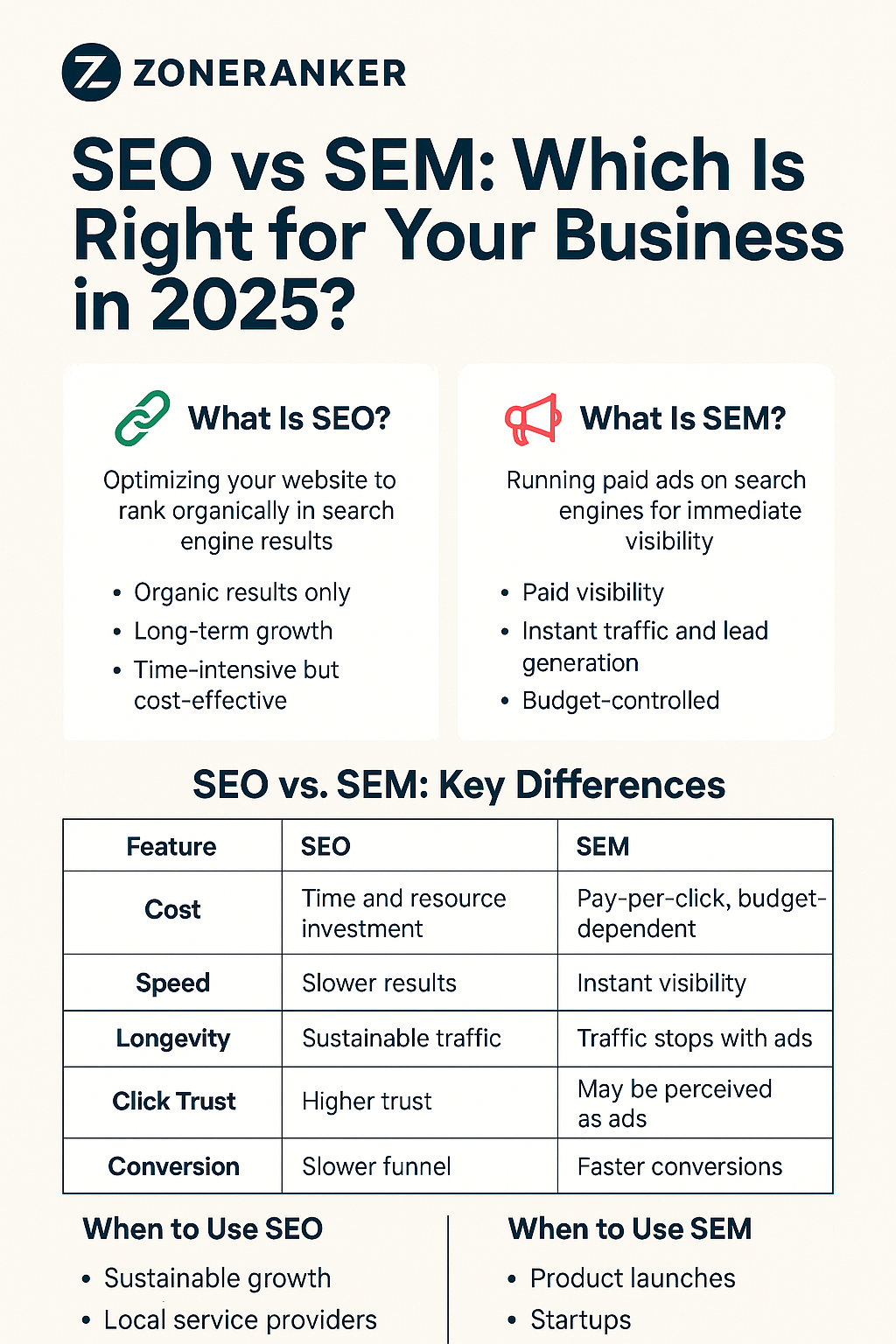In today’s hyper-competitive digital world, understanding the difference between SEO (Search Engine Optimization) and SEM (Search Engine Marketing) is essential for making smarter marketing decisions. Both play crucial roles in boosting visibility on search engines — but their strategies, costs, and timelines vary greatly.
At Zoneranker, we help local businesses find the perfect balance between long-term organic growth and short-term visibility through paid campaigns. Let’s dive into a comparison of SEO and SEM, when to use each, and how to leverage them for maximum ROI in 2025.

What Is SEO?
SEO is the process of optimizing your website and content to rank organically in search engine results pages (SERPs). It focuses on technical performance, keyword relevance, content quality, and backlinks.
Key Features:
- Organic results only
- Long-term growth
- Time-intensive but cost-effective over time
- Includes technical SEO, on-page optimization, content marketing, and off-page link building
What Is SEM?
SEM (often called PPC or paid search) involves running paid ads on search engines like Google. These ads appear above or alongside organic results.
Key Features:
- Paid visibility using platforms like Google Ads
- Instant traffic and lead generation
- Budget-controlled
- Ideal for time-sensitive promotions or competitive keywords
🔍 SEO vs. SEM: Key Differences
| Feature | SEO (Organic) | SEM (Paid) |
|---|---|---|
| Cost | Time and resource investment | Pay-per-click, budget-dependent |
| Speed | Slower results, builds over time | Instant visibility |
| Longevity | Sustainable long-term traffic | Traffic stops when ad budget ends |
| Click Trust | Higher trust from users | May be perceived as ads |
| Conversion | Slower funnel, but high-quality leads | Faster conversions (if targeting is right) |
| Testing Ability | Limited A/B testing | Easy to test ad copy, landing pages |
When to Use SEO
Ideal For:
- Businesses looking for sustainable growth
- Local service providers wanting to rank on Google Maps
- Bloggers, publishers, or ecommerce sites with long-term goals
- Websites wanting to rank for informational or long-tail keywords
Example Use Case:
A Theni-based textile business wants to rank on Google for “custom saree blouse stitching near me.” Zoneranker helps optimize their Google Business Profile, improves local content, and earns backlinks — improving organic presence for the long run.
When to Use SEM
Ideal For:
- Product launches or sales campaigns
- Startups needing immediate visibility
- Competitive markets where organic SEO takes time
- Targeting transactional keywords like “buy”, “hire”, “get quote”
Example Use Case:
A newly opened home automation shop in Madurai wants to generate leads fast. Zoneranker sets up a Google Ads campaign targeting “smart home system installation in Madurai”, with budget caps and call extensions for maximum response within a week.
Zoneranker Insight: The Local Business Sweet Spot
For local businesses, the smartest strategy is often a blended approach:
Zoneranker-Recommended Local SEO + SEM Plan:
- SEO: Optimize for “near me” keywords, build citations, and maintain your Google Business Profile.
- SEM: Run location-targeted campaigns for high-conversion services and offers during peak seasons.
- Combined: Use SEM to fill gaps while SEO builds long-term dominance.
Final Thoughts: SEO or SEM — or Both?
There’s no one-size-fits-all answer. But here’s the Zoneranker formula:
If you want lasting growth → Start with SEO
If you want fast leads → Use SEM
If you want both → Combine them with a Zoneranker strategy
Whether you’re a local café in Cumbum or a regional IT service provider, the key is understanding how both channels can work together, not just in isolation.
📞 Want a custom SEO + SEM roadmap for your business?
Visit zoneranker.com/digital-marketing-and-seo-services to schedule your free consultation.


